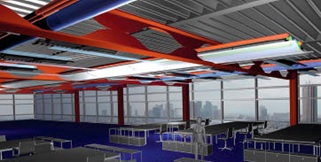ArcelorMittal presents concepts and advantages of climate-friendly building
by David Fleschen

Society is changing in favor of sustainability and the construction industry is developing along with it. This is a necessary development, which is particularly evident with regard to the use of resources in the construction sector: 40 percent of global energy consumption, 40 percent of CO2 emissions, 30 percent of natural resources, 30 percent of waste and 20 percent of water consumption is attributable to the construction sector. The challenge: to meet the world's growing demand while reducing the impact on the environment. Steel may be a solution to adress this challenge.
"As a material that can be recycled and reused indefinitely, steel offers many advantages for climate-friendly construction in urban areas. Faster and more efficient construction becomes possible, and CO2 emissions for construction are significantly reduced. The awarding of public projects in Germany should therefore in future promote sustainable building materials and construction methods - as with steel. Criteria such as environmental impact in production and use, reusability and recyclability should play a major role in this context," comments Amit Sengupta, Vice President of ArcelorMittal Europe - Long Products, with regard to climate protection and urban construction.
Steligence® - more sustainable and cost-efficient construction
ArcelorMittal aimst to think holistically. For this reason, the company has developed a concept with Steligence® to build more sustainably and cost-effectively. The building philosophy is based on scientific knowledge and creates a basis for the approach in the construction industry. The building is seen as integrated into the urban environment, as a living unit, and requirements such as sustainability, flexibility, economy and creativity are taken into account. The wide range of products offers solutions for every architectural and constructional challenge to optimize economic and increasingly social and ecological aspects.
Economic advantages of steel as a material
Due to the constructive possibilities, space and height can be used optimally. The use of innovative perforated web girders and composite ceilings allows for reduced building heights, resulting in average cost savings of eleven percent for facades, stairs and central building components. The high degree of prefabrication of wall and roof elements or composite ceilings based on steel increases the efficiency and at the same time the quality of the execution on the construction site.
Steel buildings weigh less than concrete buildings, which means that the foundation dimensions can be optimized. A like-for-like approach can accordingly reduce foundation costs by up to 40 percent on average.
Perforated web beams are mainly used for large spans. As an example we take a building with a span of 13 meters. The use of innovative perforated web girders makes it possible to dispense with the intermediate support that must be present in the concrete solution. Office space can thus be reconfigured more quickly, which increases the rental value. The speed of construction also plays a role - steel solutions can be implemented up to twice as fast as concrete. The construction cost savings are up to 24 percent. The operating costs for the building, taking into account all economic advantages, are at least 15 percent lower than the initial value, including all concept components.
Sheet piling - an intelligent choice for the future
However, steel is not only used above ground: load-bearing capacity, retention function and fire protection are the aspects that are important for the structural design of underground car parks. Steel sheet piling and steel piles are the economical alternative to reinforced concrete retaining walls when it comes to environmental friendliness, durability, construction progress and cost efficiency. Sheet piles can take over horizontal and vertical load-bearing capacity for the remaining structure as required. No other shoring system can be installed so quickly - even when building in confined spaces. Up to about 40 percent of the costs and up to 25 percent of the construction time can be saved when building an underground car park. In addition, the sheet piles can be recovered from the ground during dismantling. In this way, steel as a building material contributes to the circular economy and at the same time makes it possible to leave behind an unpolluted building ground.
Source and Photo: ArcelorMittal

